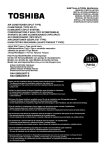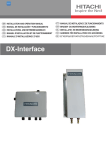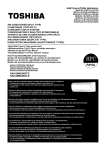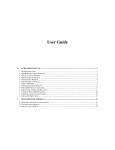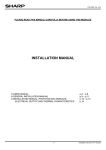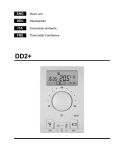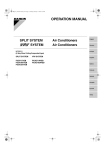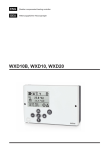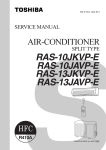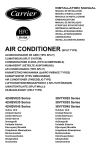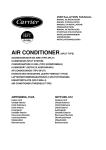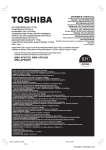Download RAV-SM562KRT-E RAV-SM802KRT-E
Transcript
INSTALLATION MANUAL MANUEL D’INSTALLATION INSTALLATIONS-HANDBUCH MANUALE D’INSTALLAZIONE MANUAL DE INSTALACIÓN MANUAL DE INSTALAÇÃO INSTALLATIE HANDLEIDING ΕΓΧΕΙΡΙ∆ΙΟ ΕΓΚΑΤΑΣΤΑΣΗΣ AIR CONDITIONER (SPLIT TYPE) CLIMATISEUR (TYPE SPLIT) KLIMAGERÄT (SPLIT-SYSTEM) CONDIZIONATORE D’ARIA (TIPO SCOMPONIBILE) APARATO DE AIRE ACONDICIONADO (TIPO SPLIT) AR CONDICIONADO (TIPO SPLIT) AIRCONDITIONER (GESPLITST TYPE) ΚΛΙΜΑΤΙΣΤΙΚΟ ΜΗΧΑΝΗΜΑ (∆ΙΑΙΡΟΎΜΕΝΟΣ ΤΎΠΟΣ) <High-Wall Type>/<Type mural haut> <Wandmontierter Typ>/<Tipo a condotto nascosto> <Modelo de pared>/<Tipo Mural> <Hoog-Wandtype>/<Τύττος Υψηλού Τοίχου> Heat Pump Model/Modèle à thermopompe Geräte mit Heizung/Modello con pompa di riscaldamento Modelo con bomba de calor/Modelo de bomba térmica Model met warmtepomp/Μοντέλο µε Αντλία Θερµ*τητας Indoor Unit/Unité intérieure Raumeinheit/Unità interna Unidad interior/Unidade interior Binnenunit/Εσωτερική Μονάδα RAV-SM562KRT-E RAV-SM802KRT-E Please read this Installation Manual carefully before installing the Air Conditioner. • This Manual describes the installation method of the indoor unit. • For installation of the outdoor unit, follow the Installation Manual attached to the outdoor unit. Veuillez lire attentivement ce Manuel d’installation avant d’installer le climatiseur. • Ce manuel décrit la procédure d’installation de l’unité intérieure. • Pour installer l’unité extérieure, reportez-vous au Manuel d’installation fourni avec l’unité extérieure. Bitte lesen Sie dieses Handbuch sorgfältig, bevor Sie mit der Installation des Klimagerätes beginnen. • In diesem Handbuch wird die Installation der Raumeinheit beschrieben. • Um die Außeneinheit zu installieren, folgen Sie den Anweisungen in dem Handbuch, das der Außeneinheit beiliegt. Prima di installare il condizionatore d’aria, leggere con attenzione questo manuale d’installazione. • Questo manuale descrive il metodo d’installazione dell’unità interna. • Per l’installazione dell’unità esterna, fare riferimento al manuale d’installazione fornito insieme all’unità esterna. Lea atentamente este Manual de instalación antes de proceder a la instalación del aparato de aire acondicionado. • Este manual describe el método de instalación de la unidad interior. • Para la instalación de la unidad exterior, consulte el Manual de instalación que acompaña a la unidad exterior. Leia atentamente o presente Manual de Instalação antes de instalar o Ar Condicionado. • O presente manual descreve o método de instalar a unidade interior. • Para a instalação de uma unidade exterior, siga o Manual de Instalação que acompanha a unidade exterior. Lees deze installatie handleiding zorgvuldig door voordat u de airconditioner gaat installeren. • Deze installatie methode beschrijft de installatiemethode van de binnenunit. • Zie voor de installatie van de buitenunit, de installatiehandleiding bij de buitenunit. Παρακαλώ διαßάστε προσεχτικά το Ενχειρίδιο Ενκατάστασης πριν απ* την ενκατασταση του Κλιµατιστικού. • Το παρ*ν Ενχειρίδιο περινράφει τη µέθοδο ενκατάστασης της εσωτερικής µονάδας. • Για την ενκατάσταση της εξωθερικής µονάδας, ακολουθήστε το Ενχειρίδιο Ενκατάστασης που συνοδεύει την εξωτερική µονάδα. ADOPTION OF NEW REFRIGERANT • This Air Conditioner is a new type which adopts a new refrigerant HFC (R410A) instead of the conventional refrigerant R22 in order to prevent destruction of the ozone layer. UTILISATION DU NOUVEAU REFRIGERANT • Ce climatiseur est d’un type inédit qui utilise le nouveau réfrigérant HFC (R410A) au lieu du réfrigérant traditionnel R22, afin d’éviter la destruction de la couche d’ozone. EINFÜHRUNG EINES NEUEN KÜHLMITTELS • Dies ist ein neuartiges Klimagerät. Anstatt des herkömmlichen Kühlmittels R22 verwendet es das neuen ozonschicht-schonende HFC Kühlmittel R410A. ADOZIONE DI UN NUOVO REFRIGERANTE • Questo condizionatore d’aria è di un tipo nuovo che adotta un nuovo refrigerante HFC (R410A) al posto del refrigerante convenzionale R22, per prevenire la distruzione dello strato di ozono dell’atmosfera terrestre. ADOPCIÓN DE NUEVO REFRIGERANTE • Este aparato de aire acondicionado es un modelo reciente que incorpora el nuevo refrigerante HFC (R410A) en lugar del refrigerante convencional R22 para así evitar daños en la capa de ozono. ADOPÇÃO DO NOVO REFRIGERANTE • Este ar condicionado é um modelo novo que adopta um novo refrigerante HFC (R410A) em vez do refrigerante convencional R22 para evitar a destruição da cama de ozono. TOEPASSING VAN EEN NIEUW KOELMIDDEL • Deze airconditioner is een nieuwe type dat werkt met een nieuw koelmiddel HFC (R410A) in plaats van met het conventionele koelmiddel R22, als bijdrage om de aantasting van de ozonlaag te reduceren. YIOΘETHΣH NEOY ΨYKTIKOY • To παρv Kλιµατιστικ είναι νέος τύπος που υιοθετεί νέο ψυκτικού HFC (R410A) στη θέση του συµβατικού ψυκτικού R22 προκειµένου να βοηθήσει στην προστασία του ζοντος. REFRIGERANT PIPING ................................................................ 8 ELECTRICAL WORK .................................................................. 11 TEST RUN ................................................................................... 14 TROUBLESHOOTING ................................................................ 15 INDOOR UNIT OPERATION WHEN CONNECTED TO MULTIPLE UNITS ......................................... 17 ENGLISH 6 7 8 9 10 TUYAUTERIE DE FLUIDE FRIGORIGÈNE .................................. 8 INSTALLATION ELECTRIQUE .................................................. 11 ESSAI DE FONCTIONNEMENT ................................................. 14 DEPANNAGE .............................................................................. 15 FONCTIONNEMENT DE L’UNITE INTERIEURE EN CAS DE RACCORDEMENT DE PLUSIEURS UNITES ............. 17 FRANÇAIS CONTENTS Accessory parts and parts to be procured locally ........................... 1 1 PRECAUTIONS FOR SAFETY ..................................................... 2 2 INSTALLATION PROCEDURE .................................................... 4 3 SELECTION OF INSTALLATION PLACE .................................... 5 4 INSTALLATION OF INDOOR UNIT .............................................. 5 5 DRAIN PIPING WORK .................................................................. 6 SOMMAIRE Pièces accessoires et pièces non fournies ....................................... 1 1 MESURES DE SECURITE ............................................................ 2 2 PROCEDURE D’INSTALLATION ................................................. 4 3 SELECTION DU LIEU D’INSTALLATION .................................... 5 4 INSTALLATION DE L’UNITE INTERIEURE ................................. 5 5 INSTALLATION DES TUYAUX D’EVACUATION ........................ 6 6 7 8 9 10 6 7 8 9 10 KÜHLMITTELLEI TUNGSSYSTEM .............................................. 8 ELEKTROINSTALLATION ......................................................... 11 TESTLAUF .................................................................................. 14 FEHLERBESEITIGUNG .............................................................. 15 BETRIEB DER RAUMEINHEIT BEI MEHREREN ANGESCHLOSSENEN EINHEITEN ........................................... 17 DEUTSCH INHALT Zubehör und bauseits bereitzustellende Teile .................................. 1 1 SICHERHEITSVORKEHRUNGEN ................................................ 2 2 INSTALLATIONSABLAUF ........................................................... 4 3 AUSWAHL DES AUFSTELLUNGSORTES ................................. 5 4 INSTALLATION DER RAUMEINHEIT .......................................... 5 5 INSTALLATION DER ABLAUFROHRE ....................................... 6 6 7 8 9 10 TUBAZIONI DEL REFRIGERANTE .............................................. 8 ESECUZIONE DEI COLLEGAMENTI ELETTRICI ..................... 11 FUNZIONAMENTO DI PROVA ................................................... 14 GUIDA PER I PROBLEMI DI FUNZIONAMENTO ...................... 15 FUNZIONAMENTO DELL’UNITA INTERNA QUANDO È COLLEGATA A PIU UNITA ................................... 17 ITALIANO INDICE Accessori e parti da acquistare sul posto ......................................... 1 1 PRECAUZIONI PER LA SICUREZZA .......................................... 2 2 PROCEDURA D’INSTALLAZIONE .............................................. 4 3 SCELTA DEL POSTO D’INSTALLAZIONE ................................. 5 4 INSTALLAZIONE DELL’UNITÀ INTERNA ................................... 5 5 LAVORO PER TUBAZIONE DI SCARICO ................................... 6 TUBERÍA DE REFRIGERANTE ................................................... 8 TRABAJOS EN EL SISTEMA ELÉCTRICO ............................... 11 PRUEBA DE FUNCIONAMIENTO .............................................. 14 SOLUCIÓN DE PROBLEMAS .................................................... 15 FUNCIONAMIENTO DE LA UNIDAD INTERIOR CUANDO ESTÁ CONECTADA A VARIAS UNIDADES ............ 17 ESPAÑOL TUBAGEM DE REFRIGERANTE ................................................. 8 LIGAÇÕES ELÉCTRICAS .......................................................... 11 ENSAIO DE FUNCIONAMENTO ................................................ 14 RESOLUÇÃO DE PROBLEMAS ................................................ 15 FUNCIONAMENTO DA UNIDADE INTERIOR QUANDO ESTÁ LIGADA A VÁRIAS UNIDADES ..................... 17 PORTUGUÊS KOELMIDDELLEI DINGEN .......................................................... 8 ELEKTRISCH GEDEELTE ......................................................... 11 WERKINGSTEST ........................................................................ 14 STORINGEN VERHELPEN ........................................................ 15 WERKING VAN BINNENMODULE BIJ AANSLUITING OP MEERDERE MODULES ....................................................... 17 ÍNDICE Acessórios e peças adquiridas localmente ...................................... 1 1 PRECAUÇÕES DE SEGURANÇA ............................................... 2 2 PROCEDIMENTO DE INSTALAÇÃO ........................................... 4 3 SELECÇÃO DO LOCAL DE INSTALAÇÃO ................................ 5 4 INSTALAÇÃO DA UNIDADE INTERIOR ..................................... 5 5 INSTALAÇÃO DA TUBAGEM DE DRENAGEM .......................... 6 6 7 8 9 10 INHOUD Accessoires en niet meegeleverde onderdelen ................................ 1 1 VOORZORGSMAATREGELEN VOOR UW VEILIGHEID ............ 2 2 INSTALLATIEPROCEDURE ........................................................ 4 3 KEUZE VAN DE LOCATIE VOOR DE INSTALLATIE ................. 5 4 INSTALLATIE VAN DE BINNENUNIT .......................................... 5 5 AFVOERLEIDINGEN .................................................................... 6 6 7 8 9 10 ΠΕΡΙΕΧΟΜΕΝΑ Παρελκµενα ανταλλακτικά και εξαρτήµατα απ την τοπική αγορά ........................................................................................ 1 1 ΠΡΟΦΥΛΑΞΕΙΣ ΑΣΦΑΛΕΙΑΣ ........................................................ 2 2 ∆ΙΑ∆ΙΚΑΣΙΑ ΕΓΚΑΤΑΣΤΑΣΗΣ .................................................... 4 3 ΕΠΙΛΟΓΗ ΤΟΥ ΧΩΡΟΥ ΕΓΚΑΤΑΣΤΑΣΗΣ ................................... 5 4 ΕΓΚΑΤΑΣΤΑΣΗ ΤΗΣ ΕΣΩΤΕΡΙΚΗΣ ΜΟΝΑ∆ΑΣ ......................... 5 5 ΕΓΚΑΤΑΣΤΑΣΗ ΣΩΛΗΝΩΣΕΩΝ ΑΠΟΣΤΡΑΓΓΙΣΗΣ ................... 6 6 7 8 9 10 ΣΩΛΗΝΩΣΕΙΣ ΨΥΚΤΙΚΟΥ ........................................................... 8 ΗΛΕΚΤΡΟΛΟΓΙΚΑ ...................................................................... 11 ∆ΟΚΙΜΗ ΛΕΙΤΟΥΡΓΙΑΣ ............................................................. 14 ΑΝΤΙΜΕΤΩΠΙΣΗ ΠΡΟΒΛΗΜΑΤΩΝ ........................................... 15 ΛΕΙΤΟΥΡΓΙΑ ΤΗΣ ΕΣΩΤΕΡΙΚΗΣ ΜΟΝΑ∆ΑΣ, ΚΑΤΑ ΤΗ ΣΎΝ∆ΕΣΉ ΤΗΣ ΜΕ ΠΟΛΛΑΠΛΕΣ ΜΟΝΑ∆ΕΣ ................... 17 EΛΛΗΝΙΚΑ 6 7 8 9 10 NEDERLANDS CONTENIDO Componentes accesorios y componentes de obtención local ....... 1 1 PRECAUCIONES PARA SU SEGURIDAD .................................. 2 2 PROCEDIMIENTO DE INSTALACIÓN ......................................... 4 3 SELECCIÓN DEL LUGAR DE INSTALACIÓN ............................ 5 4 INSTALACIÓN DE LA UNIDAD INTERIOR ................................. 5 5 TRABAJOS DE CANALIZACIÓN DE DESAGÜE ........................ 6 Accessory parts and parts to be procured locally ❑ Accessory parts Part No. Part name Q’ty Part No. Shape Part name Q’ty 1 Installation plate 1 6 Bio-enzyme & Gingko filter 2 2 Installation Manual 1 7 Wireless remote controller 1 3 Owner’s Manual 1 8 Remote controller holder 1 4 Mounting screw ∅4 mm x 25 mm 8 9 Screw for remote control holderler 2 5 Sasa-Zeolite plus filter 2 Shape Wired remote controller is an optional part sold separately. ❑ Parts to be procured locally Connecting cable H07RN-F or 245IEC66 (1.5 mm2 or more) Connecting pipe (Liquid side) (6.35 mm (diam.), Nominal (diam.) 1/4" thick 0.8 mm) RAV-SM562KRT-E Thermal insulation for refrigerant pipe (10 mm or more, thermal insulating foam polyethylene) (9.52 mm (diam.), Nominal (diam.) 3/8" thick 0.8 mm) RAV-SM802KRT-E Thermal insulation for drain pipe (10 mm or more, foam polyethylene) Connecting pipe (Gas side) (12.7 mm (diam.), Nominal (diam.) 1/2" thick 0.8 mm) RAV-SM562KRT-E Drain pipe (Outer 16 mm (diam.)) Tapes (15.9 mm (diam.), Nominal (diam.) 5/8" thick 1.0 mm) RAV-SM802KRT-E EN Grounding cable (2.0 mm (diam.) or more) 1 PRECAUTIONS FOR SAFETY ENGLISH 1 • • • • Ensure that all Local, National and International regulations are satisfied. Read this “PRECAUTIONS FOR SAFETY” carefully before Installation. The precautions described below include the important items regarding safety. Observe them without fail. After the installation work, perform a trial operation to check for any problem. Follow the Owner’s Manual to explain how to use and maintain the unit to the customer. • Turn off the main power supply switch (or breaker) before the unit maintenance. • Ask the customer to keep the Installation Manual together with the Owner’s Manual. CAUTION New refrigerant air conditioner installation • THIS AIR CONDITIONER ADOPTS THE NEW HFC REFRIGERANT (R410A) WHICH DOES NOT DESTROY OZONE LAYER. The characteristics of R410A refrigerant are ; easy to absorb water, oxidizing membrane or oil, and its pressure is approx. 1.6 times higher than that of refrigerant R22. Accompanied with the new refrigerant, refrigerating oil has also been changed. Therefore, during installation work, be sure that water, dust, former refrigerant, or refrigerating oil does not enter the refrigerating cycle. To prevent charging an incorrect refrigerant and refrigerating oil, the sizes of connecting sections of charging port of the main unit and installation tools are charged from those for the conventional refrigerant. Accordingly the exclusive tools are required for the new refrigerant (R410A). For connecting pipes, use new and clean piping designed for R410A, and please care so that water or dust does not enter. Moreover, do not use the existing piping because there are problems with pressure-resistance force and impurity in it. CAUTION To disconnect the appliance from main power supply This appliance must be connected to the main power supply by means of a switch with a contact separation of at least 3 mm. The installation fuse (25A D type ) must be used for the power supply line of this conditioner. WARNING • Ask an authorized dealer or qualified installation professional to install/maintain the air conditioner. Inappropriate installation may result in water leakage, electric shock or fire. • Turn off the main power supply switch or breaker before attempting any electrical work. Make sure all power switches are off. Failure to do so may cause electric shock. • Connect the connecting cable correctly. If the connecting cable is connected in a wrong way, electric parts may be damaged. • When moving the air conditioner for the installation into another place, be very careful not to enter any gaseous matter other than the specified refrigerant into the refrigeration cycle. If air or any other gas is mixed in the refrigerant, the gas pressure in the refrigeration cycle becomes abnormally high and it may resultingly causes pipe burst and injuries on persons. • Do not modify this unit by removing any of the safety guards or by by-passing any of the safety interlock switches. • Exposure of unit to water or other moisture before installation may cause a short-circuit of electrical parts. Do not store it in a wet basement or expose to rain or water. 2 EN 1 PRECAUTIONS FOR SAFETY • After unpacking the unit, examine it carefully if there are possible damage. • Do not install in a place that might increase the vibration of the unit. • To avoid personal injury (with sharp edges), be careful when handling parts. • Perform installation work properly according to the Installation Manual. Inappropriate installation may result in water leakage, electric shock or fire. • When the air conditioner is installed in a small room, provide appropriate measures to ensure that the concentration of refrigerant leakage occur in the room does not exceed the critical level. • Install the air conditioner securely in a location where the base can sustain the weight adequately. • Perform the specified installation work to guard against an earthquake. If the air conditioner is not installed appropriately, accidents may occur due to the falling unit. • If refrigerant gas has leaked during the installation work, ventilate the room immediately. If the leaked refrigerant gas comes in contact with fire, noxious gas may generate. • After the installation work, confirm that refrigerant gas does not leak. If refrigerant gas leaks into the room and flows near a fire source, such as a cooking range, noxious gas might generate. • Electrical work must be performed by a qualified electrician in accordance with the Installation Manual. Make sure the air conditioner uses an exclusive power supply. An insufficient power supply capacity or inappropriate installation may cause fire. • Use the specified cables for wiring connect the terminals securely fix. To prevent external forces applied to the terminals from affecting the terminals. • Conform to the regulations of the local electric company when wiring the power supply. Inappropriate grounding may cause electric shock. • Do not install the air conditioner in a location subject to a risk of exposure to a combustible gas. If a combustible gas leaks, and stays around the unit, a fire may occur. EN 3 2 INSTALLATION PROCEDURE Installation diagram of indoor unit 65 mm or more The auxiliary piping can be connected to the left, rear left, rear, right or bottom. 170 or m mm ore For the rear left and left piping Hook Wall Installation plate Right Hoo Rear Bottom Rear left Insert the cushion between the indoor unit and wall, and tilt the indoor unit for better operation. 170 or m mm ore k Left Do not allow the drain hose to get slack. Insulate the refrigerant pipes separately with insulation, not together. Air filte r Cut the piping hole sloped slightly. Shield pipe 6 mm thick heat resisting polyethylene foam Make sure to run the drain hose sloped downward. Mounting screw Mounting the installation plate 55 65 Hook For installation of the indoor unit. 170 120 0 80 100 Installation plate 180 100mm 100mm Indoor unit Hook Pipe hole Hook Indoor unit Pipe hole Thread Weight Mounting screw When the installation plate is directly mounted on the wall 1. Securely fix the installation plate to the wall by screwing it through the upper and lower fixing holes. 2. To mount the installation plate on a concrete wall with anchor bolts, utilize the anchor bolt holes as illustrated in the above figure. 3. Attach the installation plate horizontally to the wall. CAUTION When installing the installation plate with mounting screw, do not use the anchor bolt hole. Otherwise the unit may fall down and result in personal injury and property damage. ∅5 mm hole Mounting screw ∅4 x 25 mm Anchor bolt Projection 15 mm or less Clip anchor (local parts) 4 EN 3 SELECTION OF INSTALLATION PLACE WARNING • Install the air conditioner where there is sufficient strength to withstand the weight of the unit. If the strength is not sufficient, the unit may fall down resulting in injury. CAUTION Upon approval of the customer, install the air conditioner in a place that satisfies the following conditions. • Place where the unit can be installed horizontally. • Place where a sufficient servicing space can be ensured for safe maintenance and check. • Place where drained water will not cause any problem. Avoid installing in the following places. • Place exposed to air with high salt content (seaside area), or place exposed to large quantities of sulfide gas (hot spring). (Should the unit be used in these places, special protective measures are needed.) • Place exposed to oil, vapor, oil smoke or corrosive gas. • Place where organic solvent is used nearby. • Place close to a machine generating high frequency. • Place where the discharged air blows directly into the window of the neighboring house. (For outdoor unit) • Place where noise of the outdoor unit is easy to transmit. (When installing the air conditioner on the boundary with the neighbor, pay due attention to the level of noise.) • Place with poor ventilation. • Where the ceiling height is more than 3 m. • Where the floor/wall/ceiling structure is unable to support the weight of the unit. 4 INSTALLATION OF INDOOR UNIT WARNING • Install the air conditioner certainly at a place to sufficiently withstand the weight. If the strength is insufficient, the unit may fall down resulting in human injury. • Perform a specified installation work to guard against an earthquake. An incomplete installation can cause accidents by the units falling and dropping. Locate the unit so as to provide uniform circulation of chilled air. Avoid locating the unit as shown in the bad-marked figures below: Good location Evenly hot or cooled Bad location Shaded area well hot or cooled Bad location Shaded area well hot or cooled If a good location is not possible, use a fan to circulate the air evenly throughout the room. EN 5 5 DRAIN PIPING WORK Piping and drain hose installation In case of right-side exit • Cut out the knockout portion by the slits with a knife or pair of wire cutters as necessary. Slit (Body right) In case of downward pipe exit • Cut out the knockout portion by the slits with a knife or pair of wire cutters as necessary. Slit (Body right) Piping via left-hand connection Bend the connecting pipe so that it is laid within 43 mm above the wall surface. If the connecting pipe is laid exceeding 43 mm above the wall surface, the indoor unit could be unstable when set on the wall. When bending the connecting pipes, always use a suitable bending tool to avoid damaging the pipes. Bend the connection pipe within a radius of 30 mm. To connect the pipe after installation of unit (figure) (To the front of the flare) 400 mm 300 mm Liquid side Gas side 43 mm Outward form of indoor unit R 30 mm Use the handle of a screwdriver, etc. NOTE If the pipe is bent incorrectly, the indoor unit could be unstable on the wall. After passing the connecting pipe through the pipe hole, connect the connecting pipe to the auxiliary pipes and insulate as necessary. 6 EN 5 DRAIN PIPING WORK CAUTION • Bind the auxiliary pipes (two) and connecting cable with tape tightly. In case of left-side pipe exit and rear-left exit, bind the auxiliary pipes (two) only with facing tape. Indoor unit Connecting cable Auxiliary pipes Drain hose Installation plate • Carefully arrange pipes so that any pipe does not stick out of the rear plate of the indoor unit. • Carefully connect the auxiliary pipes and connecting pipes to each other and cut off the insulating tape wound on the connecting pipe to avoid double-taping at the joint, then seal the joint with vinyl tape, etc. • In order to reduce the possibility of condensed water being produced within the indoor unit, make sure to insulate both the connecting pipes. (Use a suitable form of insulation material specifically design designed for refrigeration pipe work.) • When bending a pipe, ensure care is taken to prevent pipe damage. Drainage 1. Run the drain hose sloped downwards. Do not rise the drain hose. Do not form the drain hose into the waved shape. 50 mm or more Do not put the drain hose end into the drainage ditch. Do not put the drain hose end into water. 2. It is not possible to add water to the drain pan to confirm correct drainage. To do this, the unit must be operated in the COOL mode. 3. When connecting extension drain hose, insulate the connecting part of extension drain hose with pipe insulation (local procured). Pipe insulation Drain hose Inside the room Extension drain hose CAUTION Arrange the drain pipe to allow proper drainage from the unit. Incorrect drainage can result in condensation problems. This structure of this air conditioner is designed condensed water, which may form on the back of the indoor unit, into the drain pan. Therefore, do not store the power cables and other parts within the drain guide. Wall Drain guide Space for pipes EN 7 6 REFRIGERANT PIPING Refrigerant piping 1. Use copper pipe with 0.8 mm or more thickness. (In case pipe size is ∅15.9, with 1.0 mm or more.) 2. Flare nut and flare works are also different from those of the conventional refrigerant. Take out the flare nut attached to the main unit of the air conditioner, and use it. CAUTION IMPORTANT 4 POINTS FOR PIPING WORK 1. Remove dust and moisture from the inside of the connecting pipes. 2. Tight connection (between pipes and unit) 3. Evacuate the air in the connecting pipes using VACUUM PUMP. 4. Check the gas leakage. (Connected points) Permissible piping length and head They vary according to the outdoor unit. For details, refer to the Installation Manual attached to the outdoor unit. Flaring Insert a flare nut into the pipe, and flare the pipe. As the flaring sizes of R410A differ from those of refrigerant R22, the flare tools newly manufactured for R410A are recommended. However, the conventional tools can be used by adjusting projection margin of the copper pipe. B • Projection margin in flaring : B (Unit : mm) Rigid (Clutch type) R410A tool used Outer diam. of copper pipe 6.4 to 15.9 Conventional tool used R410A R22 R410A R22 0 to 0.5 (Same as left) 1.0 to 1.5 0.5 to 1.0 Imperial (Wing nut type) Outer diam. of copper pipe R410A R22 6.4 or 9.5 1.5 to 2.0 1.0 to 1.5 12.7 or 15.9 2.0 to 2.5 1.5 to 2.0 • Flaring diam. meter size : A (Unit : mm) A +– 00.4 Outer diam. of copper pipe 6.4 R410A R22 9.1 9.0 9.5 13.2 13.0 12.7 16.6 16.2 15.9 19.7 19.2 * In case of flaring for R410A with the conventional flare tool, pull it out approx. 0.5 mm more than that for R22 to adjust to the specified flare size. The copper pipe gauge is useful for adjusting projection margin size. 8 A EN 6 REFRIGERANT PIPING Tightening connection CAUTION • Do not apply excessive torque. Otherwise, the nut may crack depending on the conditions. (Unit : N•m) Outer diam. of copper pipe Tightening torque 6.4 mm (diam.) 14 to 18 (1.4 to 1.8 kgf•m) 9.5 mm (diam.) 33 to 42 (3.3 to 4.2 kgf•m) 12.7 mm (diam.) 50 to 62 (5.0 to 6.2 kgf•m) 15.9 mm (diam.) 68 to 82 (6.8 to 8.2 kgf•m) • Tightening torque of flare pipe connections Pressure of R410A is higher than that of R22. (Approx. 1.6 times) Therefore, using a torque wrench, tighten the flare pipe connecting sections which connect the indoor and outdoor units of the specified tightening torque. Incorrect connections may cause not only a gas leak, but also a trouble of the refrigeration cycle. Flare at indoor unit side Flare at outdoor unit side Align the centers of the connecting pipes and tighten the flare nut as far as possible with your fingers. Then tighten the nut with a spanner and torque wrench as shown in the figure. Half union Flare nut Externally threaded side Use a wrench to secure. EN Internally threaded side Use a torque wrench to tighten. 9 6 REFRIGERANT PIPING Piping with outdoor unit • Shape of valve differs according to the outdoor unit. For details of installation, refer to the Installation Manual of the outdoor unit. Air purge Using a vacuum pump, perform vacuuming from the charge port of valve of the outdoor unit. For details, follow to the Installation Manual attached to the outdoor unit. • Never use the refrigerant sealed in the outdoor unit for air purge. REQUIREMENT For the tools such as charge hose, etc., use those manufactured exclusively for R410A. Refrigerant amount to be added For addition of the refrigerant, add refrigerant “R410A” referring to the attached Installation Manual of outdoor unit. Be sure to use a scale to charge the refrigerant of specified amount. REQUIREMENT • Charging an excessive or too little amount of refrigerant causes a trouble of the compressor. Be sure to charge the refrigerant of specified amount. • A personnel who charged the refrigerant should write down the pipe length and the added refrigerant amount in the nameplate attached to the service panel of the outdoor unit. It is necessary to troubleshoot the compressor and refrigeration cycle malfunction. Open the valve fully Open the valve of the outdoor unit fully. A 4 mm hexagonal wrench is required for opening the valve. For details, refer to the Installation Manual attached to the outdoor unit. Gas leak check Check with a leak detector or soap water whether gas leaks or not, from the pipe connecting section or cap of the valve. REQUIREMENT Use a leak detector manufactured exclusively for HFC refrigerant (R410A, R134a, etc.). Thermal insulation process Apply thermal insulation for the pipes separately at liquid side and gas side. For the thermal insulation to the pipes at gas side, be sure to use the material with heat-resisting temperature 120°C or higher. Using the attached thermal insulation material, apply the thermal insulation to the pipe connecting section of the indoor unit securely without gap. REQUIREMENT Apply the thermal insulation to the pipe connecting section of the indoor unit securely up to the root without exposure of the pipe. (The pipe exposed to the outside causes water leak.) 10 EN 7 ELECTRICAL WORK WARNING 1. Using the specified cables, ensure to connect the wires, and fix wires securely so that the external tension to the cables do not affect the connecting part of the terminals. Incomplete connection or fixation may cause a fire, etc. 2. Be sure to connect earth wire. (Grounding work) Do not connect the earth wire to gas pipe, city water pipe, lightning rod, or the earth wire of telephone. Incomplete grounding causes an electric shock. 3. For electric work, strictly follow the Local Regulation in each country and the Installation Manual, and use an exclusive circuit. Capacity shortage of power circuit or incomplete installation may cause an electric shock or a fire. CAUTION • This indoor unit has no power cord. • If incorrect/incomplete wiring is carried out, it will cause an electrical fire or smoke. • Be sure to install an earth leakage breaker that is not tripped by shock waves. If an earth leakage breaker is not installed, an electric shock may be caused. • Be sure to use the cord clamps attached to the product. • Do not damage or scratch the conductive core and inner insulator of power and inter-connecting cables when peeling them. • Be sure to comply with local regulations on running the wire from outdoor unit to indoor unit (size of wire and wiring method etc.) • Use the power cord and Inter-connecting cable of specified thickness, type, and protective devices required. REQUIREMENT • For power supply wiring, strictly conform to the Local Regulation in each country. • For wiring of power supply of the outdoor units, follow the Installation Manual of each outdoor unit. • Never connect 220 – 240V power to the terminal blocks (A, B, etc.) for control wiring. (Otherwise, the system will fail.) • Perform the electric wiring so that it does not come to contact with the high-temperature part of the pipe. The coating may melt resulting in an accident. • After connecting cables to the terminal blocks, provide a trap and fix cables with the cable clamp. • Run the refrigerant piping line and control wiring line in the same line. • Do not turn on the power of the indoor unit until vacuuming of the refrigerant pipes completes. How to wire 1. Connect the connecting cable to the terminal as identified with their respective numbers on the terminal block of indoor and outdoor unit. H07RN-F or 245IEC66 (1.5 mm2 or more) 2. Mount a leakage breaker. 3. Insulate the unsheathed redundant cords (conductors) with tape. 4. For inter-unit wiring, do not use a wire jointed to another on the way. 5. Fix the cable with cord clamp. EN 11 7 ELECTRICAL WORK Wiring between units 1. Connect the wires between the units correctly. Errors made in the connections can result in the unit malfunctioning. 2. Connect the control wires between the outdoor unit and indoor unit as shown in the figure below : Wiring connections Air inlet grille Front panel 2 1 Terminal block Cord clamp Earth line Screw Terminal cover Screw Connecting cable Cabling 1. Remove a screw and then remove cover of the electric parts box. 2. Strip wire ends (10 mm). 3. Match wire colors with terminal numbers on indoor and outdoor units’ terminal blocks and firmly screw wires to the corresponding terminals. 4. Connect the ground wires to the corresponding terminals. 5. Fix the cable with cord clamp. 6. Fix cover of the parts box and the terminal block surely with the fixing screws. Make a loop on the cable for margin of the length so that the electric parts box can be taken out during servicing. 10 10 1 2 3 40 30 Earth line Connecting cable 12 EN 7 ELECTRICAL WORK Remote controller wiring • As the remote controller wire has no polarity, there is no problem if connections to indoor unit terminal blocks A and B are reversed. Terminal block for remote controller wiring of indoor unit Terminal block A B A B Remote controller unit Remote controller wire (Field supply) Wiring diagram This wiring diagram is single combination, about twin combination see 17 page. Remote controller Remote controller cable A B 1 2 3 1 2 3 L N Indoor side Indoor/Outdoor connecting cable Outdoor side (Single phase 220 – 240V) • For details of cabling/installation of the wired remote controller, refer to the Installation Manual attached to in the wired remote controller. EN 13 8 TEST RUN Before test run • Before turning on the power supply, carry out the following procedure. 1) Using 500V-megger, check 1MΩ or more exists between the terminal block 1 to 3 and the earth. If 1MΩ or less is detected, do not run the unit. Do not apply to the remote controller circuit. 2) Check the valve of the outdoor unit being opened fully. • To protect the compressor at activation time, leave power-ON for 12 hours or more be for operating. How to execute a test run Using the remote controller, operate the unit as usual. For the procedure of the operation, refer to the attached Owner’s Manual. A forced test run can be executed in the following procedure if the operation stops by thermo.-OFF. (This method is limited to when wired remote controller is installed.) In order to prevent a serial operation, the forced test run is released after 60 minutes have passed and returns to the usual operation. CAUTION When the remote controller is used for the first time, it accepts an operation approx. 5 minutes after the power supply has been turned on. It is not a trouble, but is because the setup of the remote controller is being checked. For the second power-ON time and after, approx. 1 minute is required to start the operation by the remote controller. NOTE Do not use the forced test run for cases other than the test run because it applies an excessive load to the devices. 14 EN 8 TEST RUN In case of wired remote controller TEMP. FILTER RESET TEST ON / OFF 2, 4 3 TIMER SET FAN MODE TIME SWING/FIX VENT SET CL UNIT 1, 5 Procedure Description Keep TEST button pushed for 4 seconds or more. 1 [TEST] is displayed on the display part and the selection of mode in the test mode is permitted. 2 Push Using ON / OFF MODE button. button, select the operation mode, [COOL] or [HEAT]. 3 • Do not run the air conditioner in a mode other than [COOL] or [HEAT]. • The temperature controlling function does not work during test operation. • The detection of error is performed as usual. 4 After the test operation, push 9 ON / OFF button to stop the operation. (Display part is same as procedure 1.) Push 5 TEST TEST button to cancel (release from) the test operation mode. ([TEST] disappears on the display part and the status returns to a normal stop status.) TROUBLESHOOTING Incase of wired remote controller Confirmation and check When a trouble occurred in the air conditioner, the check code and the indoor unit No. appear on the display part of the remote controller. The check code is only displayed during the operation. If the display disappears, operate the air conditioner according to the following “Confirmation of error history” for confirmation. EN CODE No. UNIT No. R.C. Check code 15 No. Indoor unit No. in which an error occurred 9 TROUBLESHOOTING TEMP. Confirmation of error history When a trouble occurred on the air conditioner, the trouble history can be confirmed with the following procedure. (The trouble history is stored in memory up to 4 troubles.) The history can be confirmed from both operating status and stop status. Procedure 2 FILTER RESET TEST TIMER SET FAN MODE TIME SWING/FIX VENT SET CL UNIT 1 3 Description SET When pushing display appears. 1 ON / OFF and TEST buttons simultaneously for 4 seconds or more, the right CODE No. If [ ] is displayed, the mode enters in the error history mode. • [01: Order of error history] is displayed in CODE No. window. • [Check Code] is displayed in CHECK window. • [Indoor unit address in which an error occurred] is displayed in UNIT No. Every pushing , UNIT No. R.C. No. buttons, the error history stored in the memory is displayed in order. The numbers in CODE No. indicates CODE No. [01] (Latest) → [04] (Oldest). 2 CAUTION Do not push 3 CL button because all the error history of the indoor unit will be deleted. After confirmation, push TEST button to return to the usual display. 1. Check the troubles according to the above procedure. 2. Ask an authorized dealer or qualified service (maintenance) professional to repair or maintain the air conditioner. 3. More details of the service code are explained in Service Manual. Incase of wireless remote controller Check the indication of the display panel on the main unit. (Typical example) Lamp indication Cause Power supply is not turned on. Miscabling between sensor unit and indoor unit Measures Check cable connection and correct it. No indication even if the remote control is operated. Defective connection between sensor unit and indoor unit Miscabling or defective connection between indoor unit and outdoor units Protective device of outdoor unit works. Check outdoor unit. Protective device of indoor unit works. Check indoor unit. Flashes alternatively Flashes alternatively 1. Ask an authorized dealer or qualified service (maintenance) professional to repair or maintain the air conditioner. 2. More details of the service code are explained in Service Manual. 16 EN 10 INDOOR UNIT OPERATION WHEN CONNECTED TO MULTIPLE UNITS Twin combination Two indoor units can be operated with single outdoor unit. (However, each indoor unit cannot be operated individually). • Use RBC-TWP30E and 50E of branch pipe kit (optional) for twin combination. • For piping connection, refer to this manual and the installation manual of outdoor branch pipe kit. Wiring diagram for twin combination Wiring of each indoor unit should be H07RN-F or 245IEC66 (1.5 mm or more). Wiring of remote controller should be Twist wire (2-core with non-polarity: 0.5 mm2 - 2.0 mm2. Address can be set automatically. (Address setting will be executed for 5 minutes after the power is turned on.) There is no need to change the address setting. (The main unit is indoor unit that receives START/STOP signal from the wireless remote control.) Remote Controller A B Main Indoor Unit A B Sub Indoor Unit 1 2 3 1 3 1 2 3 2 Indoor unit connecting line Outdoor Unit L Control line N Other connecting line Power supply CAUTION Make sure to check the wiring before turning on the power. When connecting by twin combination, make sure that no wiring is made to No.3 terminal block of sub unit. (Air conditioner may not work after the power is turned on.) Group combination When executing group control on multiple unit system Group control of up to 8 units is available with single remote controller. Use wired remote controller for group control. • For wiring and wiring procedures for individual system (using the same refrigerant), refer to the installation manual of each combination. • Wiring between systems should be done by the following procedures: Connect the remote-controller terminal plate (A, B) on the indoor unit, to which the remote controller is connected, to the terminal plate (A, B) on each of other indoor units by linking them with each other with remote controller wiring. • Automatic address setting commences when the power is turned on. After 3 minutes, “SETTIN” will be indicated on the display panel to show that the address is being set. EN 17 10 INDOOR UNIT OPERATION WHEN CONNECTED TO MULTIPLE UNITS Automatic address setting takes approximately 5 minutes until completion. (Group Control of Single System) Outdoor unit Outdoor unit Outdoor unit Outdoor unit Indoor unit Indoor unit Indoor unit Indoor unit Outdoor unit Indoor unit Ln L L1 L2 L3 (up to 8 units) After the power is turned on, address setting will be completed Remote controller Control line Other connecting line • Length of wires for remote controller (L) should be 200 m (in case of using wireless remote receiver), 300 m (another controller) or less. • Length of wires for remote controller should be 200 m or shorter in total (i.e., L1 + L2 +…. Ln). NOTE Some group control system configuration requires manual address change after automatic address setting. • System configuration that requires address change is the combined system where twin and triple system of multiple units are controlled by group control with single remote controller. (Group Control on Combined System) (For example) System (Single system) Unit No. (Twin system) (Twin system) Outdoor unit Outdoor unit Sample procedure Outdoor unit Indoor unit Indoor unit Indoor unit Indoor unit (Example of random setting) Unit on which automatic address is set After changed by manual address setting Indoor unit Remote controller Address : 1-1-1 System address (Remote controller indicated R.C. ) (Example of address setting change) Block of dotted lines represents each system. Address : 2-1-2 Address : 3-3-1 Address : 2-1-2 Address : 2-2-2 When the power is turned on, the above addresses are set by automatic address setting. However, system address and indoor unit address are randomly set and thus the address setting should be changed by manual address setting so that system address and indoor unit address are matched. Group address Indoor address Address : 1-1-1 Address : 3-1-2 Address : 2-2-2 Address : 3-1-2 Address : 3-2-2 • Change and check of address should be carried out by the following procedures. 18 EN 10 INDOOR UNIT OPERATION WHEN CONNECTED TO MULTIPLE UNITS To change all the indoor addresses from an arbitrary wired remote controller (When the setup operation with automatic address has finished, this change is available.) Contents : Using an arbitrary wired remote controller, the indoor unit address can be changed for each same refrigerant cycle line. * Change the address in the address check/change mode. (Operation while air conditioner stops) Procedure example 1 Manual address setup procedure While the operation stops, change the setup. (Be sure to stop the operation of the unit.) 7 CODE No. SET DATA SETTING TEST UNIT No. R.C. No. TEMP. 3-2, 4-2, 5-2 7 1 FILTER RESET TEST ON / OFF TIMER SET FAN MODE TIME SWING/FIX VENT SET CL UNIT 3-1, 4-1, 5-1, 6 2, 6 3-3, 4-3, 5-3 Procedure Description TEST SET CL Push simultaneously + + buttons for 4 seconds or more. After a while, the display part flashes as shown below. Check the displayed ITEM CODE is [10]. CODE No. SET DATA SETTING TEST UNIT No. TEST 1 • When the ITEM CODE is other than [10], push button to erase the display and repeat procedure from the first step. TEST (After pushing button, operation of the remote controller is not accepted for approx. 1 minute.) (For a group control, No. of the firstly displayed indoor unit becomes the header unit.) R.C. No. (∗ Display changes according to the model No. of indoor unit.) UNIT 2 3-1 Every pushing button, the indoor unit No. in the group control is displayed in order. Select the indoor unit of which setup is changed. In this time, the position of the indoor unit of which setup is changed can be confirmed because fan and flap of the selected indoor unit operate. Using temp. setup / buttons, specify ITEM CODE [12]. (ITEM CODE [12]: Line address) Indoor unit No. before setup change is displayed. CODE No. SET DATA SETTING TEST 3-2 Using timer time / UNIT No. buttons, change the line address from [3] to [2]. R.C. No. CODE No. Push SET SET DATA SETTING TEST button. UNIT No. R.C. 3-3 In this time, the setup finishes when the display changes from flashing to lighting. 4-1 Using temp. setup / buttons, specify ITEM CODE [13]. (ITEM CODE [13]: Indoor address) No. Indoor unit No. before setup change is displayed. CODE No. SET DATA SETTING TEST 4-2 Using timer time / UNIT No. buttons, change the indoor address from [3] to [2]. R.C. No. CODE No. SET DATA SETTING TEST In this time, the setup finishes when the display changes from flashing to lighting. R.C. 4-3 EN UNIT No. 19 No. 10 INDOOR UNIT OPERATION WHEN CONNECTED TO MULTIPLE UNITS Procedure 5-1 Description Indoor unit No. before setup change is displayed. Using temp. setup / buttons, specify ITEM CODE [14]. (ITEM CODE [14]: Group address) CODE No. SET DATA SETTING TEST 5-2 Using timer time / UNIT No. buttons, change the setup data from [0001] to [0002]. R.C. No. (Setup data [Header unit: 0001] [Follower unit: 0002]) CODE No. Push 5-3 SET SET DATA SETTING TEST button. UNIT No. R.C. In this time, the setup finishes when the display changes from flashing to lighting. If there is other indoor unit to be changed, repeat procedure 2 to 5 to change the setup. No. Indoor unit No. before setup change is displayed. UNIT When the above setup has finished, push to select the indoor unit No. before change of setup, specify ITEM CODE [12], [13], [14] in order with temp. / buttons, and then check the changed contents. setup CODE No. SET DATA SETTING TEST UNIT No. R.C. No. Address change check Before change: [3-3-1] → After change: [2-2-2] 6 The contents during setup operation can be returned to original by pushing CODE No. CL SET DATA SETTING TEST UNIT No. button. R.C. No. CODE No. SET DATA SETTING TEST UNIT No. R.C. No. TEST 7 After check of the changed contents, push button. (Setup is determined.) When TEST pushing button, the display disappears and the status becomes the usual stop TEST status. (When pushing button, SETTING flashes and the operation from the remote controller is not accepted for approx. 1 minute.) SETTING • If the operation from the remote controller is not accepted even 1 minute or more TEST button, it is considered that the address setup is incorrect. passed after pushing In this case, the automatic address must be again set up. Therefore repeat procedure of the setup change from the Procedure 1. 20 EN 10 INDOOR UNIT OPERATION WHEN CONNECTED TO MULTIPLE UNITS When you want to know position of the indoor unit using the address To confirm the unit numbers in a group control (Operation while the air conditioner stops) The indoor unit numbers in a group control are successively displayed, and the corresponding indoor fan is turned on. Procedure Description Push 1 + TEST buttons simultaneously for 4 seconds or more. • UNIT No. is displayed. • The fans of all the indoor units in a group control are turned on. CODE No. UNIT No. UNIT 2 3 EN Every pushing button, the indoor unit numbers in the group control are successively displayed. • The firstly displayed unit numbers indicates the address of the main unit. • Only fan of the selected indoor unit is turned on. Push TEST button to finish the procedure. All the indoor units in group control stop. 21 R.C. No. TEMP. FILTER RESET TEST ON / OFF TIMER SET FAN MODE TIME SWING/FIX VENT SET CL UNIT MEMO EN 1074008001-1



























